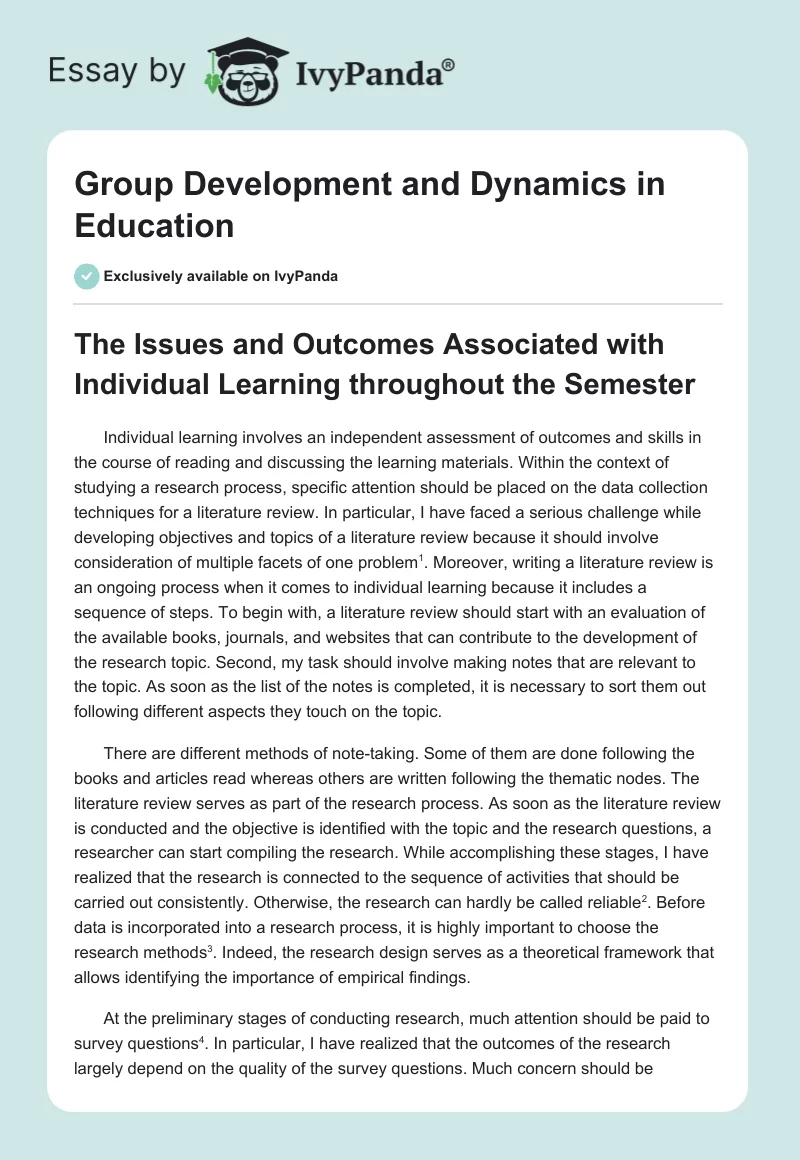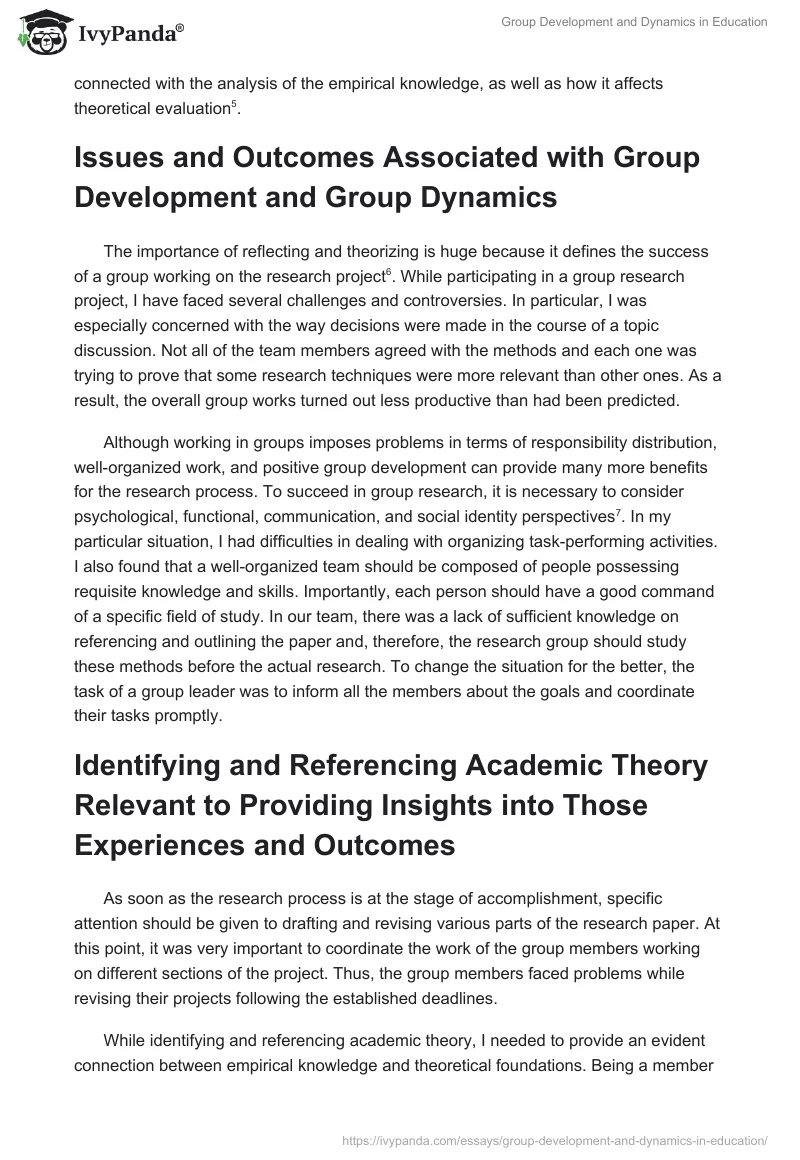The Issues and Outcomes Associated with Individual Learning throughout the Semester
Individual learning involves an independent assessment of outcomes and skills in the course of reading and discussing the learning materials. Within the context of studying a research process, specific attention should be placed on the data collection techniques for a literature review. In particular, I have faced a serious challenge while developing objectives and topics of a literature review because it should involve consideration of multiple facets of one problem. Moreover, writing a literature review is an ongoing process when it comes to individual learning because it includes a sequence of steps. To begin with, a literature review should start with an evaluation of the available books, journals, and websites that can contribute to the development of the research topic. Second, my task should involve making notes that are relevant to the topic. As soon as the list of the notes is completed, it is necessary to sort them out following different aspects they touch on the topic.
There are different methods of note-taking. Some of them are done following the books and articles read whereas others are written following the thematic nodes. The literature review serves as part of the research process. As soon as the literature review is conducted and the objective is identified with the topic and the research questions, a researcher can start compiling the research. While accomplishing these stages, I have realized that the research is connected to the sequence of activities that should be carried out consistently. Otherwise, the research can hardly be called reliable. Before data is incorporated into a research process, it is highly important to choose the research methods. Indeed, the research design serves as a theoretical framework that allows identifying the importance of empirical findings.
At the preliminary stages of conducting research, much attention should be paid to survey questions. In particular, I have realized that the outcomes of the research largely depend on the quality of the survey questions. Much concern should be connected with the analysis of the empirical knowledge, as well as how it affects theoretical evaluation.
Issues and Outcomes Associated with Group Development and Group Dynamics
The importance of reflecting and theorizing is huge because it defines the success of a group working on the research project. While participating in a group research project, I have faced several challenges and controversies. In particular, I was especially concerned with the way decisions were made in the course of a topic discussion. Not all of the team members agreed with the methods and each one was trying to prove that some research techniques were more relevant than other ones. As a result, the overall group works turned out less productive than had been predicted.
Although working in groups imposes problems in terms of responsibility distribution, well-organized work, and positive group development can provide many more benefits for the research process. To succeed in group research, it is necessary to consider psychological, functional, communication, and social identity perspectives. In my particular situation, I had difficulties in dealing with organizing task-performing activities. I also found that a well-organized team should be composed of people possessing requisite knowledge and skills. Importantly, each person should have a good command of a specific field of study. In our team, there was a lack of sufficient knowledge on referencing and outlining the paper and, therefore, the research group should study these methods before the actual research. To change the situation for the better, the task of a group leader was to inform all the members about the goals and coordinate their tasks promptly.
Identifying and Referencing Academic Theory Relevant to Providing Insights into Those Experiences and Outcomes
As soon as the research process is at the stage of accomplishment, specific attention should be given to drafting and revising various parts of the research paper. At this point, it was very important to coordinate the work of the group members working on different sections of the project. Thus, the group members faced problems while revising their projects following the established deadlines.
While identifying and referencing academic theory, I needed to provide an evident connection between empirical knowledge and theoretical foundations. Being a member of the team, I had to collect information from all members of the team and compare the obtained results before presenting the findings and discussion section. Also, time sensitivity was another aspect that contributed to the success of the research process. Finally, group dynamics in combining academic theories have been improved significantly due to the allocation of responsibilities during interviews, surveys, and experiments. In particular, the presence of various experiences allowed me to identify certain experiences.
Overall, the research process is a sophisticated procedure involving several factors. My own experience in research activities, including individual and group challenges, has significantly expanded my understanding of the importance of conducting the study under specific stages.
References
Bouma, G and Ling R The Research Process, Oxford University Press, South Melbourne, Victoria, Australia, 2006.
Converse, JM & Presser, S Quantitative Applications in the Social Sciences, SAGE, Thousand Oaks, CA, 1986.
Drury, JL, Beaton, E, & Boiney, L Collaboration Research for Crisis Management Team, Now Publishers, US, 2010.
Fowler, FJ, Improving Survey Questions: Design and Evaluation, SAGE, Thousand Oaks, CA, 1995.
Mugo, F Sampling in Research, 2004. Web.
Veal, AJ Research Method for Leisure and Tourism: A Practical Guide, Prentice Hall, UK.
Wheelan, SA, The Handbook of Group Research and Practice, SAGE, New York 2005.


